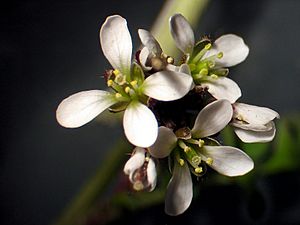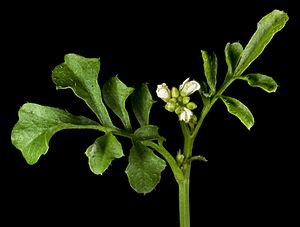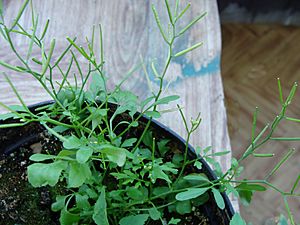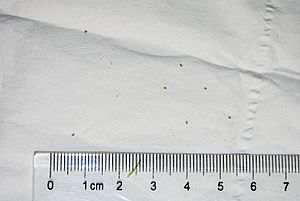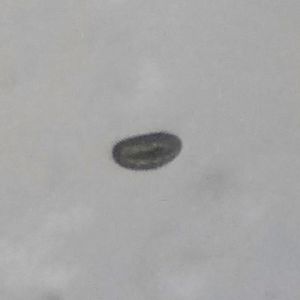Hairy bittercress facts for kids
Quick facts for kids Hairy bittercress |
|
|---|---|
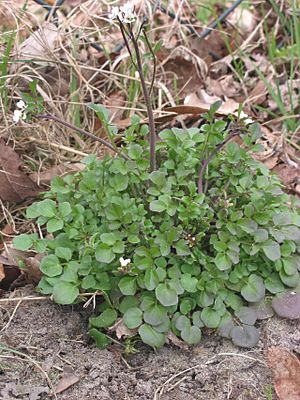 |
|
| Scientific classification | |
| Genus: |
Cardamine
|
| Species: |
hirsuta
|
| Synonyms | |
|
|
Cardamine hirsuta, also known as hairy bittercress, is a common plant found in many parts of the world. It's an annual or biennial plant, meaning it lives for one or two years. It belongs to the Brassicaceae family, which also includes plants like cabbage and broccoli. You can even eat its leaves in a salad! It often grows in damp places.
Contents
About Hairy Bittercress
This plant can grow two times a year, once in spring and again in fall, depending on the weather. Its seeds might even sprout in the fall and stay green all winter. Then, they flower in the spring.
Hairy bittercress often has a group of leaves that grow in a circle close to the ground. This is called a rosette. While some leaves grow on the upright stem, most are part of this basal rosette. These bottom leaves are usually 3.5 to 15 centimeters (about 1.4 to 6 inches) long. They are divided into 8 to 15 smaller leaf parts called leaflets. These leaflets are round or oval and can have smooth or slightly toothed edges. The leaflet at the very end of the leaf is usually bigger and more rounded.
The leaves on the upright stem are smaller and also divided into fewer leaflets. These leaves are attached to the stem by a small stalk called a petiole. They are typically 1.2 to 5.5 centimeters (about 0.5 to 2.2 inches) long. The stems, petioles, and the top of the stem leaves have a few hairs, which gives the plant its "hairy" name.
Flowers and Seeds
Hairy bittercress plants usually stand straight up and grow to about 30 centimeters (about 1 foot) tall. They have small white flowers that grow in a cluster called a raceme. These flowers quickly turn into seeds. The plant often keeps flowering even as its first seeds are getting ready.
Each flower has four small white petals, which are about 1.5 to 4.5 millimeters long. Sometimes, the petals might be missing. Unlike many related plants that have six, these flowers usually have only four stamens, which are the parts that produce pollen. The pollen grains are long, about 32 micrometers in size.
Below the flowers are four sepals, which are like small leaves that protect the flower bud. They are about 1.5 to 2.5 millimeters long.
The seeds grow inside thin, upright pods called siliquae. These pods are straight and about 1.5 to 2.5 centimeters (about 0.6 to 1 inch) long. When the seeds are ready, the pods can burst open explosively if touched! They coil tightly from bottom to top, sending the seeds flying far away from the parent plant. This way of spreading seeds is called ballochory, and it's a type of rapid plant movement.
Hairy bittercress looks a lot like another plant called Cardamine flexuosa. But there are some differences:
- Hairy bittercress stems have fewer hairs, and its leaves don't wrap around the stem.
- It has only four stamens, while C. flexuosa has six.
- In hairy bittercress, the seed pods grow taller than the younger flowers. In C. flexuosa, the pods don't grow above the flowers.
Where It Grows
Hairy bittercress loves damp, recently disturbed soil, open ground, and gardens. It's originally from Europe and North Africa. It's very common in plants bought from nurseries or garden centers, as its tiny seeds can easily come along with them. Once it starts growing, it can be hard to get rid of.
Its small white flowers attract a few early butterflies, like the spring azure (Celastrina ladon) and the falcate orange-tip (Anthocharis midea) in the United States.
Even though it's native to Europe and Asia, it has been introduced to many other countries around the world. You can find it in places like Argentina, Australia, Canada, China, Japan, the United States, and many more.
Names and History
Meaning of Its Names
- Cardamine: This name comes from the Greek language and was used by an ancient Greek doctor named Dioscorides for cress plants.
- Hirsuta: This Latin word means "hairy" or "hirsute," which describes the plant's slightly hairy stems and leaves.
Other Common Names
People call hairy bittercress by many other names, such as lamb's cress, land cress, flick weed, and shot weed. Some of these names might also be used for other plants in the Brassicaceae family.
In old English, it was called stune. This plant was even mentioned in an old Anglo-Saxon poem from the 10th century called the Nine Herbs Charm, which listed important herbs.
Uses
The leaves of hairy bittercress are safe to eat raw, especially in salads. Other soft parts of the plant can also be cooked.
See also
 In Spanish: Mastuerzo menor para niños
In Spanish: Mastuerzo menor para niños


